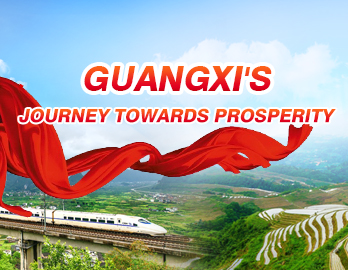Pearl River-Xijiang River Economic Belt promotes industrial transfer
Updated: 2020-03-09
In recent years, promoting the orderly transfer of regional industries has become an important theme for coordinated regional development. Improving the transfer of industry has become a key to promoting the integration of the Pearl River-Xijiang River Economic Belt into the Guangdong-Hong Kong-Macao Greater Bay Area.
Industrial transfer is not only required for industrial upgrading and sustainable development in the Greater Bay Area, but also a major focus for the rapid development of the Pearl River-Xijiang River Economic Belt. The long-term high-quality development of the Greater Bay Area cannot be separated from the strong support of the strategic hinterland of the Pearl River-Xijiang River Economic Belt, and the use of industrial transfer in the Pearl River-Xijiang River Economic Belt can attract capital, technical resources, and supporting industrial chains.
Guangxi will take the following measures to increase the capacity of the Pearl River-Xijiang River Economic Belt to transfer industries.
Creating an excellent policy environment for industrial transfer
The first step is to deepen the reform of the system and mechanism of the park to establish a market-oriented industrial park for investment promotion, development, construction, and management operations. The second is to sort out various policies and measures to attract large projects, key projects, and good projects.
The third is to accelerate the development of an enclave economy, a cross-regional administrative management and economic cooperation model that breaks the administrative division between two or more independent administrative regions to achieve coordinated economic development, thus strengthening the complementary and comprehensive cooperation of resources, industries, and talents in the eastern and western regions. The fourth is to strengthen the coordination of the construction of the pilot zone between Guangdong province and Guangxi Zhuang autonomous region.
Optimize the selection mechanism for industrial transfer
The first step is to establish a scientific industrial transfer review system and a later industrial exit mechanism. The second is to explore the directional undertaking mechanism for inter-regional benefits sharing, as well as strengthen the strategic, integrated, and coordinated development of inter-provincial industry transfer development.
The third is to build a professional think tank for industrial transfer to provide consulting services, as well as promote the exchange of talents and intelligence. The fourth is to establish a benign working mechanism and to explore incentive mechanisms to mobilize enthusiasm for industrial transfer coordination in various places.
Strengthen the support of factors for industrial transfer
The first step is to encourage universities to jointly run schools with famous universities and high-quality educational institutions in the Greater Bay Area to provide talent and intellectual support for industrial transfer. The second is to strengthen the matching of logistics planning and industrial transfer situations to meet the needs of transfer enterprises and to facilitate industrial parks.
The third is to support the cultivation and introduction of technology institutions to build a full-chain technology innovation service system. The fourth is to provide special fund support to key parks to promote high-quality development, as well as improve supporting services to form industrial development advantages.
Improve the quality and efficiency of industrial transfer
The first step is to give great support to key enterprises and launch high-quality industrial investment projects. The second is to formulate industrial cluster development policies and regional innovation policies to build the core competitiveness of industrial clusters. The third is to strengthen policy support for the creation of eco-industrial parks, promote relevant enterprises to enter the park, and establish symbiotic relationships of various industries.



